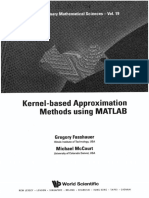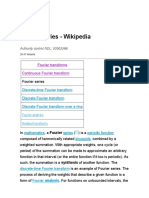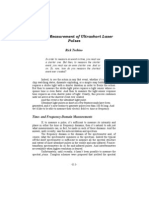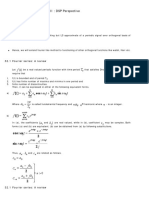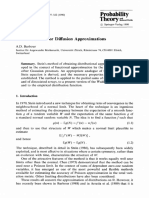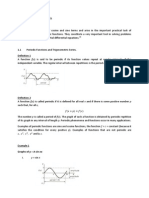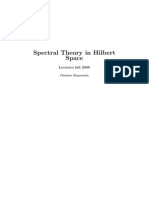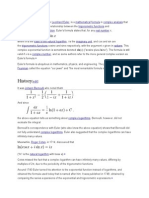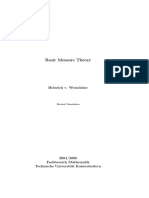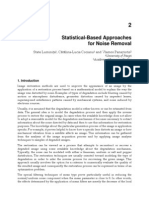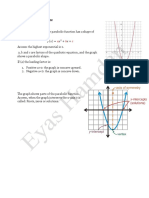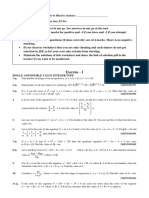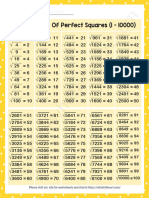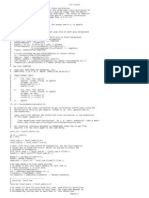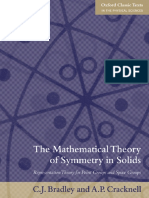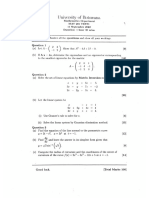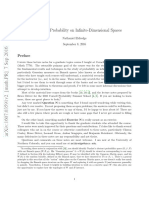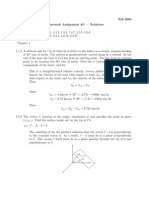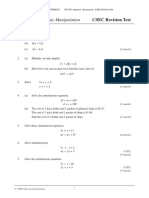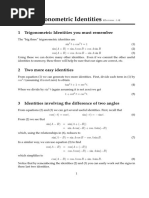Fourier Series: Background
Fourier Series: Background
Uploaded by
Joel WongCopyright:
Available Formats
Fourier Series: Background
Fourier Series: Background
Uploaded by
Joel WongOriginal Title
Copyright
Available Formats
Share this document
Did you find this document useful?
Is this content inappropriate?
Copyright:
Available Formats
Fourier Series: Background
Fourier Series: Background
Uploaded by
Joel WongCopyright:
Available Formats
Assignment
MATH1220
Joel Wong: 3128783
1. Fourier Series
Background
While Euler, D. Bernoulli and Gauss used trigonometric series before in relation to problems such as vibrating strings, Joseph Fourier (1768-1830) believed that these trigonometric series could represent arbitrary functions. He first introduced them to solve the heat equation of a metal plate.
Definition
Also known as a trigonometric series, a Fourier series is an infinite series of sine and cosine functions. If we let be a piecewise continuous function on (i.e. the period of the function is ( ) ( )) the Fourier series that converges to ( ) may be expressed as: ( ) ( ) where and ( ) ( ) ( ) (called the Fourier coefficients of ) are defined by: ( )
Note that if we do not know if the Fourier series converges to the function , we say it is the Fourier series associated with the function. Also note that this definition may be extended to include functions that have a period other than by the use of substitution. Finally, note that the Fourier series may also be expressed using complex exponentials in the place of trigonometric functions.
Convergence
Since a Fourier series is only really useful if it can be shown that it converges to the function it is meant to be representing, it is important to know the conditions under which a Fourier series converges to its associated function.
Assignment
MATH1220
Joel Wong: 3128783
The Fourier Convergence Theorem may be stated as follows (Stewart, J. 2008 [sixth edition], p5 of online appendix): If is a periodic function with period and and are piecewise continuous on ( ) is convergent. , then the Fourier series The sum of the Fourier series is equal to ( ) at all numbers where is continuous. At the numbers where is discontinuous, the sum of the Fourier series is the average of the right and left limits, that is ( ) ( )
Note: Piecewise Continuous means that there are only a finite number of jump discontinuities. A jump discontinuity is when the function jumps to a value abruptly as illustrated:
It is also possible to use Dinis Test to test the convergence of a Fourier series more precisely: Let ( )
|
(
( )|
( ) (Weisstein, E, W, 2010)
Then if
is finite, then the Fourier series converges to ( )
Example
A classic example of when Fourier series are used is the square-wave function, which may be defined by: ( ) , ( ) ( ) If you have done ELEC1700 (digital circuits), you might recognise this as the timing diagram of a clock. If you take the graph as representing a sound wave, it has the tone colour of a computers internal speaker (think of early computer game music for a comparison) The associated Fourier series is: ( )
Assignment
MATH1220
Joel Wong: 3128783
( (
( ) ) )
( ( ( ( )
( ) ) ) )
( ( ( {
( ) ( ) )) )
So the Fourier series is:
( (
) )
By the Fourier Convergence Theorem, we can say: ( ) ( ) ( ) {
Applications
Fourier series are very useful in modelling or analysing periodic phenomena, such as sound waves, electricity, heartbeats (e.g. ECG) and tides. Fourier series can also be used to solve some classes of ODEs. One interesting application of Fourier series is in analysing the the harmonics of an instrument (the greater the amount of harmonics in an instrument, the more complex the sound think of the sound of a flute vs. the sound of a violin vs. the sound of a French horn). Since the harmonics of an instrument are the second biggest factor in the instruments sound (the biggest being the players
Assignment
MATH1220
Joel Wong: 3128783
technique), analysing harmonics gives a precise basis for why instruments are different (e.g. why do Stradivarius violins tend to sound better than modern violins, and how can we replicate the waveform of these instruments) A pure sound wave is basically isomorphic to a sine wave, so by expressing a sound wave as a sum of trigonometric functions, we are essentially superimposing many pure sound waves to make a complex sound wave. Given the Fourier series: ( ) waveform by taking the nth term (i.e. ( ) ( )) called the nth harmonic. , we
are able to separate out and thus analyse the strengths of different harmonics in a instruments
The amplitude (strength) of the nth harmonic is given by . Upon computing the amplitude of several harmonics, it becomes clear that instruments with more complex tone colour have more amplitude in higher harmonics than instruments with a purer tone colour. The other trend that would be interesting to investigate would be the effect of having certain harmonics emphasised. As well as allowing more precise analysis of musical waves, Fourier series allow us to generate new tone colours by experimenting with different combinations of waves, and possibly to replicate a given tone colour.
Conclusion
A Fourier series is an infinite series of trigonometric functions and being made up of periodic functions, are very useful for investigations of periodic phenomena. The Fourier series is convergent to the associated function if the associated function is piecewise continuous over the repeating interval.
Assignment
MATH1220
Joel Wong: 3128783
2. Least Squares Approximations
Background
The idea of least squares approximations were independently formulated by Gauss, Legendre and Adrian between 1795 and 1808. The motivation for developing such a method for approximation was driven by the large amount of exploration taking place in that period of time. Explorers needed to be able to navigate accurately, and to do so, needed to be able to accurately predict the location of celestial bodies and also estimate the size of the earth. Experimental error was a large challenge to answering both of these questions, requiring better methods of approximations.
Motivation
A problem that most people who have done at least high school science would recognise is how to find the line of best fit for a set of experimental data Say you have the following data:
y 7 6 1 5 1 4 1 3 1 1 2 1 1 1 2
x 1 2 3 4 5
y 1 2 4 6 7
x 3 4 5
If you were to draw a line that was based on the first two points, you would get the following:
y 7 6 1 5 1 4 1 3 1 1 2 1 1 1 2
x 1 2 3 4 5
y 1 2 4 6 7
y prediction 1 2 3 4 5
error 0 0 1 2 2
error2 0 0 1 4 4
x 3 4 5
Assignment So the sum of the squares of the error is 9
MATH1220
Joel Wong: 3128783
Now, if you were to draw a line with the same gradient that passes through (3,4), then you would get the following results:
y 7 6 1 5 1 4 1 3 1 1 2 1 1 1 2
x 1 2 3 4 5
y 1 2 4 6 7
y prediction 2 3 4 5 6
error 1 1 0 1 1
error2 1 1 0 1 1
x 3 4 5
With this line, the sum of the squares of the error is only 4. Now, is there a methodical way to find the line with the smallest sum of the squares of the error, giving us the least squares approximation? It turns out that solving the system of equations:
Will give the required best approximation.
Definition
A least squares approximation is a procedure for numerically approximating the solution to a system that has no solution. The approximation generated minimises the squares of the sum of the errors. The least squares approximation may be computed by using the following theorem (Antont, H; Rorres, C.; 2005): If is an matrix with linearly independent column vectors, then for every matrix b, the linear system has a unique least squares solution. This solution is given by: ( ) (which is a rearranged form of ) It we wish to think of the least squares method in terms of finding the vector in the given subspace that is closest to the given vector, we come to the conclusion that any vector x that is a least squares solution of Ax=b must satisfy Ax=projwb, as the shortest distance between the closest vector in the
Assignment
MATH1220
Joel Wong: 3128783
given subspace and the given vector will be the orthogonal distance between that vector and the subspace.
Example: Line of Best Fit
(This example based on Carter, T; 2000) Suppose we have the set of data contained in the table: Then we can express a system of equations based on gradient-intercept form ( that it is true for all of the points in the data. x 1 2 3 4 5 y 2 3 7 8 9 ) such
Since it is very unlikely that there will be a and a that will fit all the equations simultaneously, we will use the least squares method to find the best approximation. First we will express the system in matrix format (i.e. Ax=b)
, [ ]
* + and [ ]
Now to find the best approximation:
+ [ * ]
* +
+ [ ]
+* +
Now this gives the augmented matrix, which we reduce by Gauss-Jordan: * | + * | + * | +
So the best approximation for c0 is 0.1, and the best approximation for c1 is 1.9. And the line of best fit is given by
Application: Fourier Series
Least squares approximations can be used to check that the Fourier series for a function actually converges to that function. This is done by checking that the mean square error approaches 0 as n approaches .
Assignment
MATH1220
Joel Wong: 3128783
The Least squares approximation procedure gives us a tool to handle the problem of if a Fourier series converges to its associated function because we may think of the problem as finding the best possible approximation to using only functions from a specified subspace (in this case, only using trigonometric functions). This allows us to use orthogonal projections onto the specified subspace to calculate the closest approximation in that subspace.
Conclusion
The least squares approximation procedure allows us to methodically find a good approximation to a unsolvable system of equations. The applications of this are wide and varied, including: allowing us to work with empirical data, allowing us to reduce the effects of interference on an analogue signal, allowing us to know when we have found the minimum error solution and in giving us tools with which we can work on other theoretical problems (such as the convergence of Fourier series).
Assignment
MATH1220
Joel Wong: 3128783
Bibliography
Anton, H. & Rorres, C. (2005) Elementary Linear Algebra (Applications Version) (9th edition), USA, John Wiley & Sons, Inc. Carter, T (2000) 8. Least Squares Approximation Retrieved 23/09/2010 from: http://ceee.rice.edu/Books/LA/leastsq/index.html Fourier series (n.d) Retrieved 23/09/2010 from: http://en.wikipedia.org/wiki/Fourier_series Fourier Series (n.d) Retrieved 23/09/2010 from: http://www.physics.miami.edu/~nearing/mathmethods/fourier_series.pdf Least squares (n.d) Retrieved 23/09/2010 from: http://en.wikipedia.org/wiki/Least_squares Lecture 2.4: Least squares approximations (n.d.) Retrieved 23/09/2010 from: http://dmpeli.mcmaster.ca/Matlab/Math4Q3/NumMethods/Lecture2-4.html Niu, R (2006) Fourier Series and Their Applications Retrieved 23/09/2010 from: http://ocw.mit.edu/courses/mathematics/18-100c-analysis-i-spring-2006/projects/niu.pdf Stewart, J (2008) Calculus (6th edition) Retrieved 23/09/2010 from: http://www.stewartcalculus.com/data/CALCULUS%206E/upfiles/topics/6e_at_01_fs_stu.pdf Stewart, J (2008) Calculus (6th edition), USA, Thompson Higher Education. Walker, J (n.d) Fourier Series Retrieved 23/09/2010 from: http://www.uwec.edu/walkerjs/media/fseries.pdf Weisstein, Eric W. Dini's Test Retrieved 23/09/2010 from: http://mathworld.wolfram.com/DinisTest.html Weisstein, Eric W. Fourier Series. Retrieved 23/09/2010 from: http://mathworld.wolfram.com/FourierSeries.html
You might also like
- Platinum Mathematics Grade 12 - 220429 - 115301 - 230408 - 210600Document409 pagesPlatinum Mathematics Grade 12 - 220429 - 115301 - 230408 - 210600Kholo Mavimbela100% (3)
- Kernel-Based Approximation Methods Using MATLABDocument9 pagesKernel-Based Approximation Methods Using MATLABCesar Vasques0% (1)
- Fismat 371 380Document16 pagesFismat 371 380Yogi Firman AndikaNo ratings yet
- Gogte Institute of Technology: (An Autonomous Institution Under Visveswaraya Technological University, Belagavi)Document13 pagesGogte Institute of Technology: (An Autonomous Institution Under Visveswaraya Technological University, Belagavi)manjunath koraddiNo ratings yet
- ApproximationDocument16 pagesApproximationJane-Josanin ElizanNo ratings yet
- 06b) Plane Wave Spectrum - 1 - 28Document8 pages06b) Plane Wave Spectrum - 1 - 28Josh GreerNo ratings yet
- Lab 2Document6 pagesLab 2SHAHZEB AFRIDINo ratings yet
- Fourier Series - Wikipedia PDFDocument34 pagesFourier Series - Wikipedia PDFAyad M Al-AwsiNo ratings yet
- MIT5 35F12 FTLectureBishofDocument14 pagesMIT5 35F12 FTLectureBishofputih_138242459No ratings yet
- Problems Based Exponential and Trigonometric Fourier Series and Its ApplicationsDocument9 pagesProblems Based Exponential and Trigonometric Fourier Series and Its ApplicationsKhushbu ThakurNo ratings yet
- Lab 04 - Seismic DeconvolutionDocument10 pagesLab 04 - Seismic Deconvolutionapi-323770220No ratings yet
- 06 Pulse Measurement TrebinoDocument88 pages06 Pulse Measurement Trebinoadeelmurtaza5730No ratings yet
- Module 9: Numerical Relaying II: DSP Perspective: Fourier AnalysisDocument10 pagesModule 9: Numerical Relaying II: DSP Perspective: Fourier Analysismatlab5903No ratings yet
- 1992 04 Application Od Uniform Linear Array Bearing Estimation Techniques To Uniform Circular Arrays PDFDocument4 pages1992 04 Application Od Uniform Linear Array Bearing Estimation Techniques To Uniform Circular Arrays PDFDania AlashariNo ratings yet
- Modal Analysis of Beams - An Experiment Symposium On Dynamic Problems of MechanicsDocument9 pagesModal Analysis of Beams - An Experiment Symposium On Dynamic Problems of MechanicsnizamshahrinNo ratings yet
- Fourier SeriesDocument14 pagesFourier Seriesshahroz12No ratings yet
- Spatial Filtering: Background: Principle of Operation and TheoryDocument26 pagesSpatial Filtering: Background: Principle of Operation and TheoryKing EverestNo ratings yet
- Tangent (Geometry) : Tangent To A Curve. The Red Line Is Tangential To The Curve at The Point Marked by A Red DotDocument41 pagesTangent (Geometry) : Tangent To A Curve. The Red Line Is Tangential To The Curve at The Point Marked by A Red DotabhishekNo ratings yet
- Application of The Ritz Method To The Analysis of Non-Linear Free Vibrations of BeamsDocument12 pagesApplication of The Ritz Method To The Analysis of Non-Linear Free Vibrations of BeamsKuldeep BhattacharjeeNo ratings yet
- Fourier SeriesDocument7 pagesFourier Seriesguntadi100% (2)
- Calculus 3 TextDocument207 pagesCalculus 3 TextAhmadMoaaz100% (1)
- Sturm-Liouville Eigenvalue ProblemsDocument34 pagesSturm-Liouville Eigenvalue ProblemsPrasad Uday BandodkarNo ratings yet
- Hamel' S Theorem: A. W. MarrisDocument21 pagesHamel' S Theorem: A. W. MarrisDante FreidzonNo ratings yet
- MathemagicsDocument71 pagesMathemagicsFevzi Yasin100% (1)
- AlternativeHessenberg Frangos Conference 14-11-23Document15 pagesAlternativeHessenberg Frangos Conference 14-11-23Constantine KirichesNo ratings yet
- Barbour - Stein's Method F or Diffusion ApproxDocument26 pagesBarbour - Stein's Method F or Diffusion ApproxJoey CarterNo ratings yet
- Volterra SeriesDocument5 pagesVolterra SeriesAnimasahun Olamide HammedNo ratings yet
- Markov Semigroups: Paolo GuiottoDocument26 pagesMarkov Semigroups: Paolo GuiottoChristina JonesNo ratings yet
- Fourier Series: Graphs of y A Sin NXDocument14 pagesFourier Series: Graphs of y A Sin NXSiti Zulaiha UyubNo ratings yet
- Hilbert Spaces SpectraDocument139 pagesHilbert Spaces SpectraYatrik SolankiNo ratings yet
- Time Series Via Fractals GeometryDocument35 pagesTime Series Via Fractals GeometryhemaNo ratings yet
- Notes 07. Fourier Series ErrorsDocument7 pagesNotes 07. Fourier Series ErrorsJean ReneNo ratings yet
- Jagers 86 OnDocument4 pagesJagers 86 OngsabhishekNo ratings yet
- Problems: TABLE 10.2.1 Values of The Error eDocument10 pagesProblems: TABLE 10.2.1 Values of The Error edinizobardoNo ratings yet
- Euler FormulaDocument29 pagesEuler FormulaAlone EulerNo ratings yet
- Sampling Theory With Applications Using MATLAB: Anna Maeser April 21, 2008Document16 pagesSampling Theory With Applications Using MATLAB: Anna Maeser April 21, 2008hord72No ratings yet
- Euler's FormulaDocument8 pagesEuler's FormulaP.LauricaNo ratings yet
- Introduction To Hilbert Spaces. I.: (KS) G. Sparr, A Sparr: "Kontinuerliga System", Studentliterature, Lund (2000)Document5 pagesIntroduction To Hilbert Spaces. I.: (KS) G. Sparr, A Sparr: "Kontinuerliga System", Studentliterature, Lund (2000)Anonymous PkeI8e84RsNo ratings yet
- Fourier Analysis - Introduction From A Practical Point of ViewDocument8 pagesFourier Analysis - Introduction From A Practical Point of ViewSingam SridharNo ratings yet
- PhaseDocument7 pagesPhaseUtkal Ranjan MuduliNo ratings yet
- R, N ( P, P ) : Introduction and Basic PropertiesDocument4 pagesR, N ( P, P ) : Introduction and Basic PropertiesRidhi KhuranaNo ratings yet
- Notes 2Document117 pagesNotes 2Mustafiz AhmadNo ratings yet
- Classical Model Theory of FieldsDocument16 pagesClassical Model Theory of FieldsDiego CameloNo ratings yet
- 1 s2.0 S0304397500002176 MainDocument15 pages1 s2.0 S0304397500002176 MainGrâce Dorcas Akpéné AMOUZOUNo ratings yet
- 2017-01-20-015145 @R Basicmeasuretheory - Skript PDFDocument51 pages2017-01-20-015145 @R Basicmeasuretheory - Skript PDFDat NguyenNo ratings yet
- InTech-Statistical Based Approaches For Noise RemovalDocument26 pagesInTech-Statistical Based Approaches For Noise RemovalWaff EltNo ratings yet
- 1-s2.0-S0045782597001370-mainDocument17 pages1-s2.0-S0045782597001370-mainminh1505No ratings yet
- Signal Analysis: 1.1 Analogy of Signals With VectorsDocument29 pagesSignal Analysis: 1.1 Analogy of Signals With VectorsRamachandra ReddyNo ratings yet
- Math Before Calculus (Find The Tangent Line Without Calculus)Document10 pagesMath Before Calculus (Find The Tangent Line Without Calculus)Michael DyNo ratings yet
- B.tech-Ee-4th Sem-S& SDocument147 pagesB.tech-Ee-4th Sem-S& SManav RajputNo ratings yet
- Local Nash Inequality and Inhomogeneity of Heat KernelsDocument23 pagesLocal Nash Inequality and Inhomogeneity of Heat KernelsJorge PachasNo ratings yet
- ChenRobert Thesis2016Document46 pagesChenRobert Thesis2016UJJAWAL KUMARNo ratings yet
- 1987 - The Robustness of Multidimensional Signalling Equilibria - HuangDocument4 pages1987 - The Robustness of Multidimensional Signalling Equilibria - HuangFernando SoteroNo ratings yet
- Transformation FourierDocument3 pagesTransformation FourierTanvir Ahmed DipNo ratings yet
- Fundition ChaosDocument25 pagesFundition ChaosRogério da silva santosNo ratings yet
- Fourier Series IntroductionDocument58 pagesFourier Series IntroductionAnna RominaNo ratings yet
- Wavelet Methods For Time Series AnalysisDocument45 pagesWavelet Methods For Time Series Analysisbogdan.oancea3651No ratings yet
- Introduction to the Mathematics of Inversion in Remote Sensing and Indirect MeasurementsFrom EverandIntroduction to the Mathematics of Inversion in Remote Sensing and Indirect MeasurementsNo ratings yet
- Lecture 07: Stress Transformation and Equilibrium Equations: Dept. of Mechanical Engg., NIT CalicutDocument11 pagesLecture 07: Stress Transformation and Equilibrium Equations: Dept. of Mechanical Engg., NIT CalicutManoj MallickNo ratings yet
- Re Ning The Stern Diatomic Sequence - Richard Stanley, Herbert WilfDocument10 pagesRe Ning The Stern Diatomic Sequence - Richard Stanley, Herbert Wilfgauss202No ratings yet
- Wa0011.Document33 pagesWa0011.mohamed.mouhihaNo ratings yet
- 9.quadratic FunctionDocument13 pages9.quadratic Function25 Mahdi DawoodNo ratings yet
- Algebra TilesDocument56 pagesAlgebra Tilesboostoberoi100% (1)
- Math 8-Q2-Week-4Document21 pagesMath 8-Q2-Week-4Joshrel V. CieloNo ratings yet
- An Introduction To Matrices: MatrixDocument6 pagesAn Introduction To Matrices: MatrixJuliet FangNo ratings yet
- Assignment MAL 201 Z-TransDocument1 pageAssignment MAL 201 Z-TransVijay GargNo ratings yet
- WS7 IntegerDocument6 pagesWS7 Integerpriyanshu rawatNo ratings yet
- Math1011 As UuDocument1 pageMath1011 As UuTeklu AnbeseNo ratings yet
- Square Roots of Perfect Squares 1 10000Document2 pagesSquare Roots of Perfect Squares 1 10000mdmasoom7770No ratings yet
- VI. Multiple Choice. Encircle The Letter of Your AnswerDocument5 pagesVI. Multiple Choice. Encircle The Letter of Your AnswerJohn Paul Basiño100% (1)
- Colliot-Thelene J. Quadratic Forms, Linear Algebraic Groups, and Cohomology PDFDocument359 pagesColliot-Thelene J. Quadratic Forms, Linear Algebraic Groups, and Cohomology PDFPaulina Anguiano Díaz de la VegaNo ratings yet
- Function Normxcorr2Document3 pagesFunction Normxcorr2informal77No ratings yet
- (Christopher Bradley, Arthur Cracknell) The MathemDocument758 pages(Christopher Bradley, Arthur Cracknell) The Mathemloubnan100% (1)
- KS5 "Full Coverage": Exponentials & Logarithms: (Edexcel C2 May 2011 Q3a)Document13 pagesKS5 "Full Coverage": Exponentials & Logarithms: (Edexcel C2 May 2011 Q3a)Chai Min HiungNo ratings yet
- Mat291 Test 1 Marking KeyDocument7 pagesMat291 Test 1 Marking KeymoatlhodiNo ratings yet
- 2111 08754Document17 pages2111 08754Kanan MahammadliNo ratings yet
- Boyce/Diprima 9 Ed, CH 2.1: Linear Equations Method of Integrating FactorsDocument15 pagesBoyce/Diprima 9 Ed, CH 2.1: Linear Equations Method of Integrating FactorsAnonymous OrhjVLXO5sNo ratings yet
- 1607 03591Document70 pages1607 03591Sacha Christopher LauriaNo ratings yet
- CL305 PDFDocument62 pagesCL305 PDFshubham100% (1)
- Webber and Arfen Mathematical Methods For Physicists Seleceted Ch. 1 & 3 SolutionsDocument6 pagesWebber and Arfen Mathematical Methods For Physicists Seleceted Ch. 1 & 3 SolutionsJosh Brewer100% (1)
- 3D FrameDocument10 pages3D FrameZoe SinNo ratings yet
- UNIT 23 Algebraic Manipulation CSEC Revision Test: X X y X XDocument3 pagesUNIT 23 Algebraic Manipulation CSEC Revision Test: X X y X XCharlotte BNo ratings yet
- Math111 Limits and ContinuityDocument23 pagesMath111 Limits and ContinuityAbdul Halil AbdullahNo ratings yet
- Cbse x Mathematics Phase-i Centum Book 2023-24Document191 pagesCbse x Mathematics Phase-i Centum Book 2023-24parasaramvijaykumar100% (1)
- Trigonometric IdentitiesDocument3 pagesTrigonometric IdentitiesMushahid KhanNo ratings yet
- BaCal LAS1 10 - MELCs1 22Document75 pagesBaCal LAS1 10 - MELCs1 22Maria Angelica SandoyNo ratings yet

